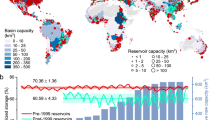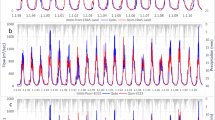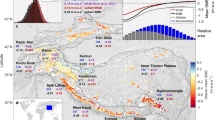Abstract
Climate change is causing widespread glacier retreat1, and much attention is devoted to negative impacts such as diminishing water resources2, shifts in runoff seasonality3, and increases in cryosphere-related hazards4. Here we focus on a different aspect, and explore the water-storage and hydropower potential of areas that are expected to become ice-free during the course of this century. For roughly 185,000 sites that are glacierized at present, we predict the potentially emerging reservoir storage volume and hydropower potential. Using a climate-driven glacier-evolution model5 and topographical analysis6, we estimate a theoretical maximal total storage and hydropower potential of 875 ± 260 cubic kilometres and 1,355 ± 515 terawatt-hours per year, respectively (95% confidence intervals). A first-order suitability assessment that takes into account environmental, technical and economic factors identifies roughly 40 per cent of this potential (355 ± 105 cubic kilometres and 533 ± 200 terawatt-hours per year) as possibly being suitable for realization. Three quarters of the potential storage volume is expected to become ice-free by 2050, and the storage volume would be enough to retain about half of the annual runoff leaving the investigated sites. Although local impacts would need to be assessed on a case-by-case basis, the results indicate that deglacierizing basins could make important contributions to national energy supplies in several countries, particularly in High Mountain Asia.
This is a preview of subscription content, access via your institution
Access options
Access Nature and 54 other Nature Portfolio journals
Get Nature+, our best-value online-access subscription
$29.99 / 30 days
cancel any time
Subscribe to this journal
Receive 51 print issues and online access
$199.00 per year
only $3.90 per issue
Buy this article
- Purchase on Springer Link
- Instant access to full article PDF
Prices may be subject to local taxes which are calculated during checkout



Similar content being viewed by others
Data availability
The data generated herein are available at http://doi.org/10.3929/ethz-b-000353109. The reference list provides information on data obtained from third parties.
Code availability
The computer codes used for evaluations are available from the corresponding author upon request.
References
Vaughan, D. et al. in Climate Change 2013: The Physical Science Basis. Contribution of Working Group I to the Fifth Assessment Report of the Intergovernmental Panel on Climate Change (eds Stocker, T. et al.) 317–382 (Cambridge Univ. Press, 2013).
Immerzeel, W. W, van Beek, L. P. H. & Bierkens, M. F. P. Climate change will affect the Asian water towers. Science 328, 1382–1385 (2010).
Huss, M. & Hock, R. Global-scale hydrological response to future glacier mass loss. Nat. Clim. Chang. 8, 135–140 (2018).
Stoffel, M. & Huggel, C. Effects of climate change on mass movements in mountain environments. Prog. Phys. Geogr. Earth Env. 36, 421–439 (2012).
Huss, M. & Hock, R. A new model for global glacier change and sea-level rise. Front. Earth Sci. 3, 54 (2015).
Farinotti, D., Pistocchi, A. & Huss, M. From dwindling ice to headwater lakes: could dams replace glaciers in the European Alps? Environ. Res. Lett. 11, 054022 (2016).
Marzeion, B., Kaser, G., Maussion, F. & Champollion, N. Limited influence of climate change mitigation on short-term glacier mass loss. Nat. Clim. Chang. 8, 305–308 (2018).
Hock, R. et al. GlacierMIP—a model intercomparison of global-scale glacier mass-balance models and projections. J. Glaciol. 65, 453–467 (2019).
Church, J. et al. in Climate Change 2013: The Physical Science Basis. Contribution of Working Group I to the Fifth Assessment Report of the Intergovernmental Panel on Climate Change (eds Stocker, T. et al.) 1137–1216 (Cambridge Univ. Press, 2013).
Terrier, S., Bieri, M., Jordan, F. & Schleiss, A. J. Impact du retrait glaciaire et adaptation du potentiel hydroelectrique dans les Alpes suisses. La Houille Blanche 1, 93–101 (2015).
Haeberli, W. et al. New lakes in deglaciating high-mountain regions—opportunities and risks. Clim. Change 139, 201–214 (2016).
Colonia, D. et al. Compiling an inventory of glacier-bed overdeepenings and potential new lakes in de-glaciating areas of the Peruvian Andes: approach, first results, and perspectives for adaptation to climate change. Water 9, 336 (2017).
Best, J. Anthropogenic stresses on the world’s big rivers. Nat. Geosci. 12, 7–21 (2019).
Pritchard, H. D. Asia’s shrinking glaciers protect large populations from drought stress. Nature 569, 649–654 (2019).
Kraftwerke Obserhasli AG. Speichersee und Kraftwerk Trift. https://www.grimselstrom.ch/ausbauvorhaben/zukunft/kraftwerk-trift/ (accessed June 2019).
International Renewable Energy Agency. Installed renewable energy capacity. http://resourceirena.irena.org/gateway/dashboard/?topic=4&subTopic=16 (2018).
Nemergut, D. et al. Microbial community succession in an unvegetated, recently deglaciated soil. Microb. Ecol. 53, 110–122 (2007).
Zarfl, C., Lumsdon, A., Berlekamp, J., Tydecks, L. & Tockner, K. A global boom in hydropower dam construction. Aquat. Sci. 77, 161–170 (2015).
Latrubesse, E. et al. Damming the rivers of the Amazon basin. Nature 546, 363–369 (2017).
RGI Consortium. Randolph Glacier Inventory—a dataset of global glacier outlines, version 6.0. Technical Report (Global Land Ice Measurements from Space (GLIMS), 2017).
Gernaat, D. E. H. J., Bogaart, P. W., van Vuuren, D. P., Biemans, H. & Niessink, R. High-resolution assessment of global technical and economic hydropower potential. Nat. Energy 2, 821–828 (2017).
Huss, M. & Farinotti, D. Distributed ice thickness and volume of all glaciers around the globe. J. Geophys. Res. 117, F04010 (2012).
van Vuuren, D. P. et al. The representative concentration pathways: an overview. Clim. Change 109, 5–31 (2011).
International Hydropower Association. Hydropower Sustainability Assessment Protocol Technical Report (International Hydropower Association, 2012).
Chao, B., Wu, Y. H. & Li, Y. S. Impact of artificial reservoir water impoundment on global sea level. Science 320, 212–214 (2008).
International Energy Agency (IEA). Key world energy statistics report 2017. https://www.iea.org/publications/freepublications/publication/KeyWorld2017.pdf (2017).
Bosson, J.-B., Huss, M. & Osipova, E. Disappearing World Heritage glaciers as a keystone of nature conservation in a changing climate. Earth's Future 7, 469–479 (2019).
The World Bank World development indicators 2018. https://datacatalog.worldbank.org/dataset/world-development-indicators (2018).
Byg, A. & Salick, J. Local perspectives on a global phenomenon—climate change in Eastern Tibetan villages. Glob. Environ. Change 19, 156–166 (2009).
Hunter, J. D. Matplotlib: a 2D graphics environment. Comput. Sci. Eng. 9, 90–95 (2007).
Jarvis, J., Guevara, E., Reuter, H. I. & Nelson, A. D. Hole-filled SRTM for the globe: version 4: data grid http://srtm.csi.cgiar.org/ (CGIAR Consortium for Spatial Information, 2008).
Tachikawa, T., Hato, M., Kaku, M. & Iwasaki, A. Characteristics of ASTER GDEM version 2. In Proc. IEEE Int. Geosci. Remote Sensing Symp. (IGARSS) 3657–3660 (IEEE, 2011).
Machguth, H. & Huss, M. The length of the world’s glaciers—a new approach for the global calculation of center lines. Cryosphere 8, 1741–1755 (2014).
Farinotti, D. et al. How accurate are estimates of glacier ice thickness? Results from ITMIX, the Ice Thickness Models Intercomparison eXperiment. Cryosphere 11, 949–970 (2017).
Jenson, S. & Domingue, J. Extracting topographic structure from digital elevation data for geographic information-system analysis. Photogramm. Eng. Remote Sensing 54, 1593–1600 (1988).
Taylor, K., Stouffer, R. & Meehl, G. An overview of CMIP5 and the experiment design. Bull. Am. Meteorol. Soc. 93, 485–498 (2012).
Lloyd, C., Sorichetta, A. & Tatem, A. High resolution global gridded data for use in population studies. Sci. Data 4, 170001 (2017).
de Ferranti, J. Digital Elevation Data http://www.viewfinderPanoramas.org/dem3.html (2014).
International Union for Conservation of Nature (IUCN) and UNEP-WCMC. KML layer of natural and mixed world heritage sites as recorded in the World Database on Protected Areas (WDPA). http://www.iucn.org/sites/dev/files/import/downloads/natural_and_mixed_world_heritage_sites_2014.kmz (2013).
International Union for Conservation of Nature (IUCN) and UNEP-WCMC. The World Database on Protected Areas (WDPA). Protected Planet https://www.protectedplanet.net/ (2017).
International Union for Conservation of Nature (IUCN) and Center for International Earth Science Information Network. Gridded species distribution: global amphibian richness grids. https://sedac.ciesin.columbia.edu/data/set/species-global-amphibian-richness-2015 (NASA Socioeconomic Data and Applications Center (SEDAC), 2015).
International Union for Conservation of Nature (IUCN) and Center for International Earth Science Information Network. Gridded species distribution: global mammal richness grids. http://sedac.ciesin.columbia.edu/data/set/species-global-mammal-richness-2015(NASA Socioeconomic Data and Applications Center (SEDAC), 2015).
Fischer, L., Purves, R., Huggel, C., Noetzli, J. & Haeberli, W. On the influence of topographic, geological and cryospheric factors on rock avalanches and rockfalls in high-mountain areas. Natural Hazards Earth Syst. Sci. 12, 241–254 (2012).
Sevestre, H. & Benn, D. Climatic and geometric controls on the global distribution of surge-type glaciers: implications for a unifying model of surging. J. Glaciol. 61, 646–662 (2015).
International Renewable Energy Agency. Renewable energy technologies: cost analysis series Vol. 1 Power Sector Issue 3/5 https://www.academia.edu/12663204/renewable_energy_technologies_cost_analysis_series (IREA, 2012).
SWECO Norge AS. Cost base for hydropower plants (with a generating capacity of more than 10,000 kW). http://publikasjoner.nve.no/veileder/2012/veileder2012_03.pdf (Norwegian Water Resources and Energy Directorate, 2012).
Hall, D., Hunt, R., Reeves, K. & Carroll, G. Parameters of US Hydropower Resources. Contract No. INEEL/EXT-03-00662. Technical Report (Idaho National Engineering and Environmental Laboratory, 2003).
SWECO Norge AS. Cost base for small-scale hydropower plants (with a generating capacity of up to 10,000 kW). http://publikasjoner.nve.no/veileder/2012/veileder2012_02.pdf (Norwegian Water Resources and Energy Directorate, 2012).
Giardini, D., Grünthal, G., Shedlock, K. M. & Zhang, P. The GSHAP global seismic hazard map. Ann. Geophys. 42, 1225–1230 (1999).
Harris, J., Bonneville, D., Kersting, R. A., Lawson, J. & Morris, P. Cost Analyses and Benefit Studies for Earthquake-Resistant Construction in Memphis, Tennessee—Design Drawings. Report No. 14-917-26, https://www.nist.gov/publications/cost-analyses-and-benefit-studies-earthquake-resistant-construction-memphis-tennessee-0. (NIST, 2013
Food and Agriculture Organization of the United Nations. FAOSTAT Annual producer prices 2015. http://www.fao.org/prices/en/#data/PP (2015).
Acknowledgements
This study was supported by the Swiss National Science Foundation (SNSF), grant number PZENP2_154290. We thank all those who made freely available any data used here; D. Gernaat for distance-to-powerline information used in the economic analysis; and D. Felix for punctual advice regarding hydropower infrastructure design.
Author information
Authors and Affiliations
Contributions
D.F. and V.R. conceived the study; M.H. produced the glacier runoff projections and provided the DEMs necessary for the analyses; D.F. conceived and implemented the code for the dam-construction analysis; V.R. conceived the suitability score system with the help of D.F. and H.Z.; V.R. performed global-scale calculations, and designed most figures; H.Z. and L.C. implemented and performed the economic analyses with the help of D.F., and assisted in figure design and production. The manuscript was drafted by V.R. and D.F., with contributions from M.H., H.Z. and L.C.
Corresponding author
Ethics declarations
Competing interests
The authors declare no competing interests.
Additional information
Publisher’s note Springer Nature remains neutral with regard to jurisdictional claims in published maps and institutional affiliations.
Peer review information Nature thanks Joseph Shea and the other, anonymous, reviewer(s) for their contribution to the peer review of this work.
Extended data figures and tables
Extended Data Fig. 1 Visualization of virtually installed dams and reservoirs.
a–f, An arbitrary subset of dams and reservoirs for locations in: a, Alaska; b, Scandinavia; c, North Asia; d, Central Asia; e, Low Latitudes; and f, New Zealand (see Extended Data Fig. 7 for the nomenclature of regions). The approximate locations of the sites are shown in the bottom right corners. Background images are from GoogleEarth (providers: a–f, DigitalGlobe; b, c, e, Landsat/Copernicus; b, d, e, CNES/Aribus; a, f, Maxar Technologies; f, Planet.com).
Extended Data Fig. 2 Temporal evolution of the total hydropower potential from all considered basins within individual regions.
Regional definitions for panels a–r are in Extended Data Fig. 7 and follow the Randolph Glacier Inventory20. Projections refer to three climate scenarios (green, blue and red) based on selected representative concentration pathways23. Temporal variations reflect variations in runoff. Note that different vertical scales are used for each row. Grey shading indicates 95% confidence intervals.
Extended Data Fig. 3 Cumulative hydropower potential and potential reservoir volume for a given suitability score.
a, b, Hydropower potential (a) and reservoir volume (b). The ‘steps’ in the suitability score are caused by some of the suitability indicators only taking discrete values, and the final suitability score being an average of three categories (see Methods). The inflection point at score 50 is marked, as are other features worth noticing. The suitability score is dimensionless.
Extended Data Fig. 4 Globally aggregated hydropower potential and potential storage volume as a function of suitability.
a, b, Hydropower potential (a) and reservoir volume (b). The score for every suitability indicator (environmental, technical or economic) is given individually. The last row of each panel shows the final suitability score (see Methods).
Extended Data Fig. 5 Hydropower potential as a function of suitability, aggregated per country.
a–o, The 15 countries with the highest cumulative hydropower potentials. Scores for individual indicators are given separately.
Extended Data Fig. 6 Cumulative hydropower energy potential as a function of production cost in different regions of the world.
a–r, Regions are defined in Extended Data Fig. 7, and are sorted according to the maximal potential for which the estimated production cost is below 0.5 USD kWh–1. Different colours depict individual cost components (see Methods and Extended Data Table 1 for calculations). Note that the panels have different scales (the grey bars in the upper right corners are always equivalent to 3 TWh yr–1).
Extended Data Fig. 7 Global distribution of the hydropower potential from deglacierizing basins, compared with present renewable electricity production.
The total maximal potential per country (blue shading) is shown as a percentage of the present renewable electricity production. Data for the latter are taken from the International Renewable Energy Agency16 for the year 2017. The red boxes indicate regions as defined in the Randolph Glacier Inventory20 and are used for aggregating data in Extended Data Figs. 2, 6. The basemap was generated using Matplotlib30.
Extended Data Fig. 8 Global distribution of the top 1,000 sites in terms of hydropower potential.
Circle sizes and colours depict the hydropower potential and the suitability score, respectively. The basemap was generated using Matplotlib30.
Extended Data Fig. 9 Conceptual representation of the procedure used for determining the design discharge QD.
Qavg is the average monthly discharge and Vres (orange area) is the volume of the reservoir. Small and large reservoirs are discerned on the basis of annual discharge: a reservoir is considered to be large if it can store half of the annual discharge or more. In this case, turbining the annual discharge every year requires QD to equal Qavg (a smaller QD would imply water accumulation from year to year, thus leading to reservoir overspill and production loss over time). Smaller reservoirs require a larger QD, because less water can temporarily be stored. Letters on the x-axis denote months.
Rights and permissions
About this article
Cite this article
Farinotti, D., Round, V., Huss, M. et al. Large hydropower and water-storage potential in future glacier-free basins. Nature 575, 341–344 (2019). https://doi.org/10.1038/s41586-019-1740-z
Received:
Accepted:
Published:
Issue Date:
DOI: https://doi.org/10.1038/s41586-019-1740-z
Comments
By submitting a comment you agree to abide by our Terms and Community Guidelines. If you find something abusive or that does not comply with our terms or guidelines please flag it as inappropriate.



